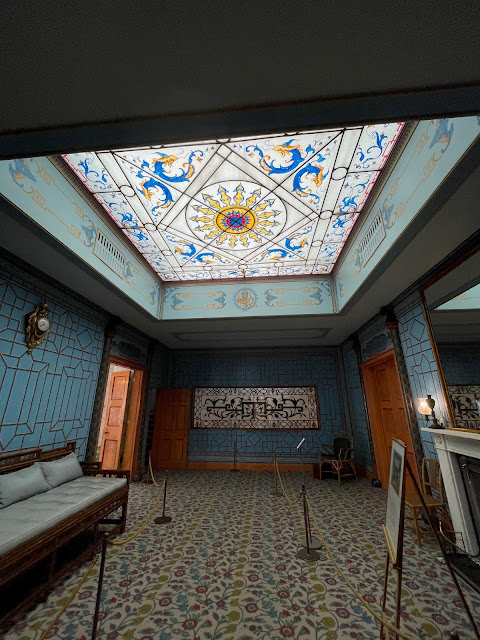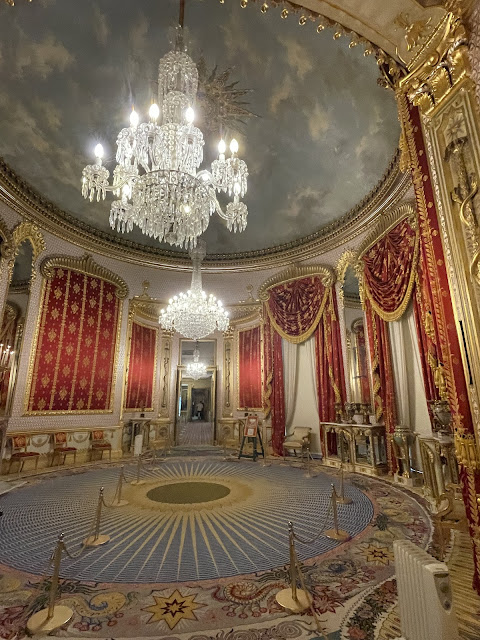In May last year, I visited Brighton on a beautiful, sunny day and was as excited as Lydia Bennet herself. I had long planned to visit Brighton Pavilion to get a real feel of Regency Britain and the opulence that the Prince Regent represented through his lavish style.
Brighton Pavilion was one of the royal residences of the Prince Regent, who replaced his father, King George III, whilst he was unable to reign the country due to mental illness, and later became King George IV. The Prince Regent lead an extravagant lifestyle, building expensive estates and throwing lavish parties, and he was widely considered an irresponsible monarch and had a scandalous reputation.
This fascinating portrait of the Prince Regent by Domenico Moglia (1829) is unbelievably a micro-mosaic made of tiny pieces of marble and semi-precious stones and weighs close to half a ton. The Prince Regent had sent a portrait of himself painted by Sir Thomas Lawrence as a gift to Pope Pius VII, and in return, the Pope had commissioned this fascinating portrait. I believe the portrait shows the Prince Regent in a more favourable light and is likely to be an "airbrushed" version of him.
Detail of the portrait where you can see some of the tiny pieces of marble.In 1787, The Prince Regent commissioned Henry Holland to create his pavilion in Brighton, as it had become a fashionable seaside resort and here, away from London, he could enjoy his clandestine affair with his mistress, Maria Fitzherbert (as despised by Jane Austen herself). Later, in 1815-1822, the building was extended and redesigned by John Nash, whose designs are still visible today.
The design of the building is heavily influenced by Indian and Chinese style. The exterior is typically indo-islamic with its distinctive domed turrets, as seen in many Indian palaces, such as the Chowmahalla Palace in Hyderabad I visited years ago (my image below).
The Chowmahalla Palace in Hyderabad.Chinese influences are visible throughout the interiors of the building.
The opulent banqueting room with its stunning chandeliers is a sight worth seeing. Food and feasting were key to the royal lifestyle here, and one can only imagine the grand dinners that took place in this room.
The chandeliers inspired by Chinese mythology are exquisite. The central chandelier hangs from the claws of a gilded dragon and weighs a ton! The walls are adorned with Chinese wall art and everything around you is gilded, shiny, luxurious.
The saloon was the formal reception room where the Prince Regent would greet his guests before taking them to the banqueting room. The gold theme with Eastern influences continues here in a repetitive, symmetrical design.
The music room was stunning as well. The Prince Regent entertained his guests with music here, had his own band and often got involved in music making too. This room must have looked incredible at night when illuminated by the many chandeliers.
The Prince Regent threw lavish parties and you can imagine large balls happening at the ballroom below.
The king's living areas were moved to the ground floor due to his growing ill health and obesity later in life. The bedroom is less opulent but the oriental influences and Regency style follow through these rooms.
Queen Victoria, who spent time at the Pavilion later on in the 19th Century, had another bedroom made, which is gorgeous - I adore the handpainted wallpaper that features birds and flowers.
The kitchen has a unique look to it with cast iron columns topped with palm tree leaves central to the room. The heavily obese, indulgent Prince Regent loved food and entertaining amd his kitchen was technologically advanced. For each banquet, 70 dishes were prepared in this impressive kitchen by French chefs.
A visit to the Brighton Pavilion is certainly memorable and the Pavilion is still a popular picnic spot today with its lush gardens and vibrant outdoor space.























What an amazing place,Anna. Great pictures.
ReplyDeleteGreat pictures Anna. Brighton is one of my favourite places. The Pavilion is amazing.
ReplyDelete